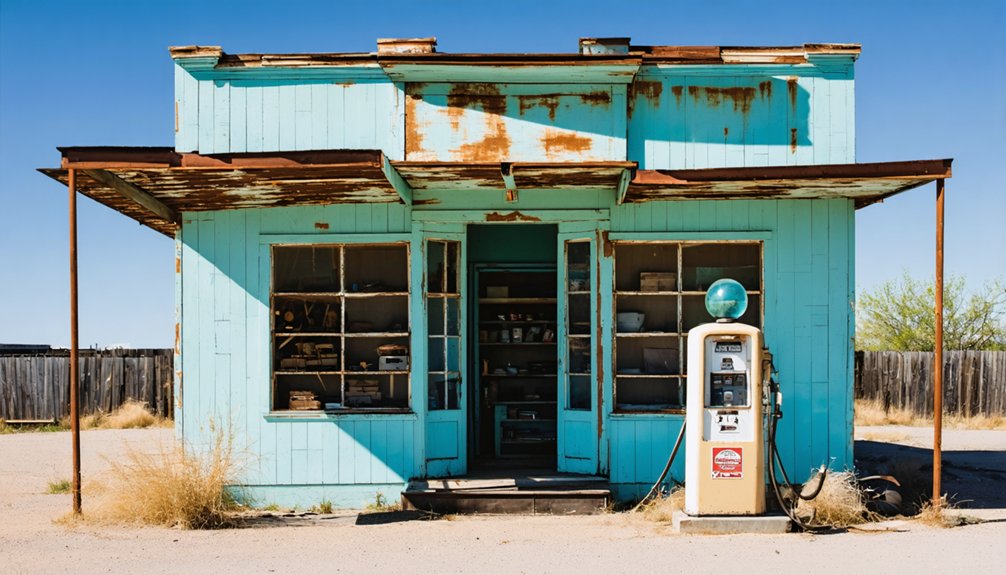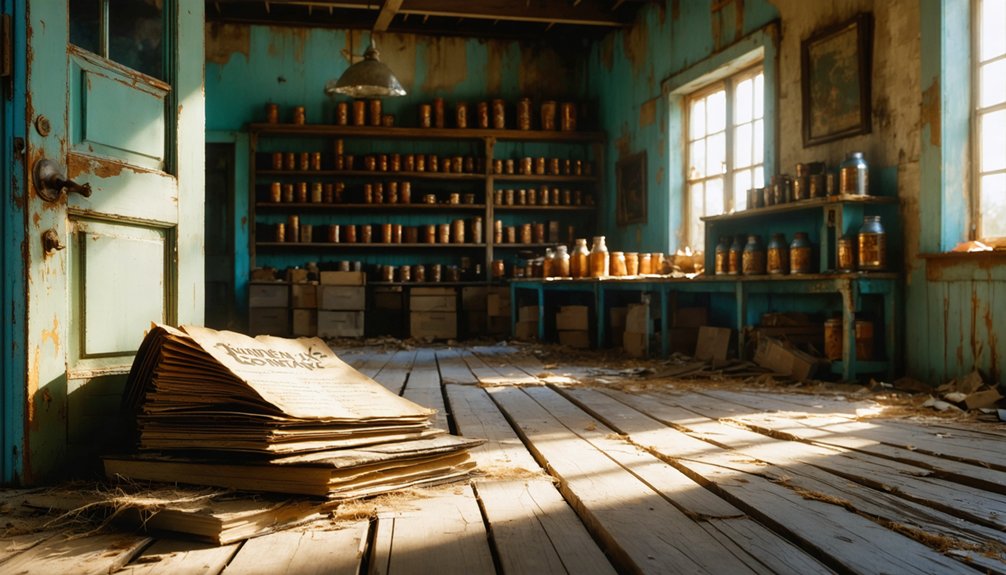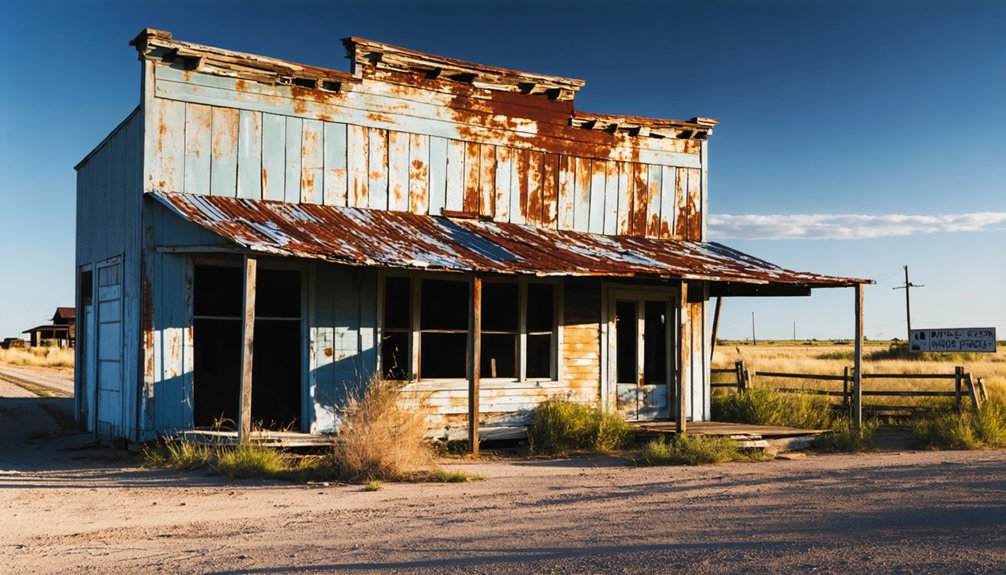You’ll find Turpentine’s ghost town site hidden in northwestern Jasper County’s dense woods, where Western Naval Stores Company once transformed East Texas’s longleaf pine forests into naval stores. In the early 1900s, the company town thrived along the Burr’s Ferry, Browndell and Chester Railroad, with workers living in company housing and using scrip at the company store. Today, nature has reclaimed the industrial settlement, leaving no visible structures to mark this fascinating chapter of Texas’s pine industry heritage.
Key Takeaways
- Turpentine, Texas was a company settlement built around turpentine production in Jasper County during the early 1900s.
- The town reached its peak around 1915 as one of 25 turpentine camps in East Texas.
- Workers lived in basic company-owned housing and relied on the company store for daily necessities.
- The settlement declined due to depleted pine forests and competition from petroleum-based solvents.
- Today, the site is completely reclaimed by East Texas wilderness, with no remaining structures or markers.
Birth of a Pine Resin Boomtown
While Native Americans had long utilized pine resin for medicinal purposes, it wasn’t until the early 1700s that British colonial demands transformed turpentine production into a booming industry.
You’ll find the turpentine origins of this Texas ghost town deeply rooted in the expansion of the industry from the Southeast into the Lone Star State’s Piney Woods region.
When “Turpentine Jim” McFarley Brown discovered the rich longleaf pine resources around Jasper County, he sparked a revolution in local resin extraction. The naval stores production became especially vital during the Civil War period.
Workers used specialized Herty cups and metal gutters to tap the valuable sap from pine trees, creating distinctive “catfaces” along the bark. The collected sap was transported in wooden barrels to processing facilities.
The town of Turpentine emerged as a hub of production, where you’d find skilled laborers operating distillation stills and transforming raw pine resin into valuable naval stores and industrial products.
Life in the Company Settlement
If you’d lived in Turpentine, Texas, you’d have started each dawn with the arduous task of collecting resin from countless longleaf pines, attaching metal buckets and chipping bark in a carefully practiced rhythm.
Your home would’ve been a basic company-owned shack, with your daily needs met through purchases at the company store that often led to mounting debt. Like many others, you might have found yourself trapped in a system of debt peonage.
You’d have found little escape from camp life, as the settlement lacked common institutions like churches or schools, keeping you tethered to the narrow world of pine resin production. The settlement grew to employ eighty men when it first opened in 1907.
Daily Worker Routines
Since daylight dictated productivity in Turpentine’s pine forests, workers began their grueling shifts at dawn, gathering their tools and heading into the dense stands of longleaf pines.
You’d find yourself assigned to specific worker roles – perhaps as a chipper cutting V-shaped faces into trees, or hauling resin-filled Herty cups to the distillery. Similar to Thurber’s miners, workers were paid with company store scrip. Safety measures were minimal; you’d wear long sleeves and boots, but they wouldn’t protect you from all hazards like sharp tools, falls, or searing heat.
Under the watchful eye of company foremen, you’d clock in and out, following strict schedules. The Western Naval Stores Company oversaw all operations at the facility starting in 1908.
During storms or extreme cold, work might halt temporarily, but you’d still need to maintain equipment and prepare for the next collection day, all while staying within the settlement’s controlled boundaries.
Housing and Social Life
After long days in the pine forests, workers returned to the company settlement‘s austere wooden houses, built hastily but strategically near the work sites. Similar to how Plemons’ population dwindled when it lost prominence, these company towns often faced rapid decline when industry moved elsewhere. Located alongside unmarked burial grounds, these settlements preserved the cultural heritage of Black American communities.
You’d find your movements restricted by company rules and fences, with guards monitoring activities to prevent worker solidarity. Despite these constraints, you’d discover ways to maintain community spirit through discreet social gatherings in homes and church meetings.
Living conditions presented constant challenges:
- Your family’s housing tenure depended entirely on your continued employment.
- You’d share limited access to clean water and basic healthcare.
- You’d rely on the company store for essential goods, deepening your economic dependence.
The isolation fostered tight-knit bonds among neighbors, though you’d face significant restrictions on visitors and organized meetings.
Religious services became crucial outlets for maintaining social connections while avoiding company scrutiny.
Railroad’s Impact on Growth
When the Burr’s Ferry, Browndell and Chester Railroad extended its line through northwestern Jasper County in 1907, it sparked tremendous growth in the region’s turpentine industry. This railroad expansion connected Rockland to Aldridge, and by 1909, reached the Western Naval Stores Company’s camp at Turpentine. Like many other towns mentioned in the Handbook of Texas including Bankersmith and Belzora, Turpentine’s fate was tied closely to its railroad connection.
You’ll find that the economic transformation was swift and far-reaching. The railroad enabled the efficient transport of pine sap and processed turpentine to broader markets, making remote operations viable.
Daily Operations and Industry
The daily rhythm of turpentine production shaped life in East Texas’s pine forests during the early 1900s.
You’d find workers tackling sap harvesting from dawn to dusk, facing labor challenges in the dense woods of Jasper and Newton counties. They’d select longleaf pines, create “cat faces,” and attach metal cups to collect the precious sap, which they’d empty weekly into waiting barrels.
Similar to abandoned camps like Belle Plain College, the turpentine sites were eventually deserted due to economic hardships.
- Workers, including Finnish and Russian immigrants alongside experienced Black laborers from Georgia and Alabama, endured harsh conditions for low wages.
- At peak production around 1915, you’d see 25 camps operating across six East Texas counties.
- The demanding work involved year-round exposure to sticky sap, turpentine fumes, and rough terrain, while workers maintained sustainable harvesting practices.
Community Structure and Facilities

Life in Turpentine centered around its industrial heart, where you’d find workers’ housing clustered near the bustling railroad and turpentine operations established in 1909.
You’d discover modest dwellings built for functionality rather than comfort, positioned strategically for quick access to work sites.
Community organization was basic but purposeful. The post office, established the same year, served as the town’s primary gathering point.
While you wouldn’t find formal schools or churches in records, the social dynamics revolved around the daily rhythm of industrial work. Workers likely shared informal bonds, though the community remained largely transient.
You’d notice the infrastructure focused on industrial needs rather than amenities, with the railroad serving as the lifeline for supplies and shipping of turpentine products.
The Fading Industrial Era
During peak production around 1915, you’d find roughly 25 turpentine camps scattered across six East Texas counties, with Jasper and Newton counties dominating 80% of the region’s output.
The bustling industrial landscape wouldn’t last forever, though, as several factors led to the industry’s decline:
Even the most thriving industries face eventual decline, as shifting markets and depleting resources reshape economic landscapes.
- The once-abundant longleaf pine forests gradually depleted, reducing the available resources for turpentine production.
- Competition from petroleum-based solvents began challenging the traditional turpentine market.
- Economic pressures forced a difficult shift as the industry struggled to maintain profitability.
You’d witness the economic shift firsthand if you’d lived in Turpentine, Texas, where the Western Naval Stores Company’s operations gradually wound down.
The town’s fate mirrored the industry’s decline, as both workers and infrastructure abandoned the once-thriving industrial community.
Legacy in East Texas History

Interwoven into East Texas’s cultural fabric, turpentine production left an indelible mark on the region’s identity and development.
You’ll find its cultural significance reflected in the stories of families like that of “Turpentine Jim” McFarley Brown, whose legacy embodies the industry’s transformative impact on local communities.
The economic transformation sparked by turpentine camps reshaped northern Jasper County’s landscape, turning dense forests into bustling company towns.
You can trace this change through the establishment of railroads, post offices, and general stores that served the diverse workforce of native East Texans, European immigrants, and African Americans.
While the industry has vanished, its influence persists in local folklore, family histories, and the physical remnants of once-thriving communities like Turpentine, Texas.
What Remains Today
Today’s visitor to Turpentine’s former location will find nothing but East Texas wilderness, as nature has completely reclaimed this once-bustling industrial town.
Time and wilderness have erased all traces of Turpentine, leaving only untamed East Texas forest where industry once thrived.
The ghostly remnants of this forgotten community have vanished beneath decades of forest growth, leaving no trace of the buildings, railroad, or industrial operations that once defined this place.
Nature’s reclamation has been so complete that you’ll discover:
- No standing structures or visible foundations from the town’s heyday
- No marked graves or memorial markers to commemorate the site’s history
- No accessible paths or roads leading to the exact location
The site remains deeply hidden within northwestern Jasper County’s dense woods, challenging even determined explorers to find evidence of its existence.
Archaeological surveys haven’t been conducted, and the land stays untouched by modern development.
Frequently Asked Questions
What Was the Average Wage of Turpentine Workers in the Early 1900S?
You’d find turpentine industry workers earning between $1-$3 daily, though wage comparisons show significant variation based on your role, with skilled stillers making more than general laborers.
Were There Any Major Accidents or Disasters During the Town’s Operation?
You won’t find specific accident reports or disaster impact records for this town’s operational period. While Texas ghost towns faced various hardships, no major catastrophes are documented here.
What Happened to the Original Residents After the Town Was Abandoned?
You’ll find most residents joined a widespread residential migration, following economic opportunities to nearby railroad towns like Aldridge, Jasper, and Colmesneil, while others likely tracked the turpentine industry to new locations.
Did Any Notable Historical Figures Ever Visit or Work in Turpentine?
You won’t find records of any famous visitors or major historical events here – the camp’s story centers on everyday workers in the turpentine and logging industries rather than notable personalities.
Were There Any Schools or Churches Established in the Settlement?
When push came to shove, you’d find no official schools or churches in the settlement. The camp’s industrial focus and transient workforce meant school history and church significance weren’t priorities.
References
- https://en.wikipedia.org/wiki/List_of_ghost_towns_in_Texas
- https://www.tylercountyhc.org/artifacts-collection-county/turpentine-jim
- https://www.allacrosstexas.com/texas-ghost-town.php?city=Turpentine
- https://www.youtube.com/watch?v=-foSXkPFal4
- https://www.texasescapes.com/DEPARTMENTS/Guest_Columnists/East_Texas_all_things_historical/Turpentiners1BB701.htm
- https://www.texasescapes.com/Texas-Ghost-Towns-A-to-Z.htm
- https://scholarworks.sfasu.edu/cgi/viewcontent.cgi?article=2014&context=ethj
- https://gumspiritsofturpentine.com/about-turpentine/history-of-turpentine/
- https://floridatrailblazer.com/category/turpentine-history/
- http://daysgoneby.me/turpentine/



